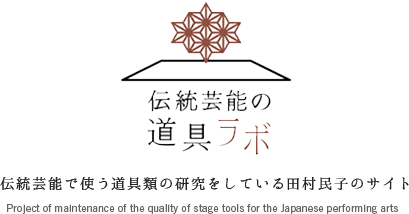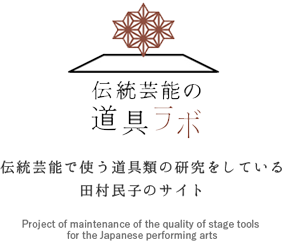鹿の子(復元) KANOKO
Vol.
00
(0) プロローグ 鹿の子復元 Prologue: Restoration of Kanoko Technique

鹿の子(復元) KANOKO
歌舞伎の女方の髪を華やかに彩る、さまざまな髪飾り。
そのなかに「鹿の子絞り」という日本伝統の染色技術が使われた「鹿の子(かのこ)」と呼ばれる布があります。
「鹿の子」は歌舞伎のお芝居のなかで、娘や遊女、女中などさまざまな役に合わせて、色や結び方を変えて使われます。なかでも世話物の名作『籠釣瓶花街酔醒』の八ツ橋という遊女の役では、この「鹿の子」がふんだんに使われます。ところが、この「鹿の子」を作る人がいないというのです…。
絞りの技術が悪くなったり、布地や染色の質が落ちたりすれば、きっと見た目も悪くなるでしょう。せっかく俳優さんがいい演技をしても、身に付けているものが安っぽいと、歌舞伎の舞台の品格も下がってしまいます。それは、とても悲しい事だと感じました。
できるかどうか、わからないけど、復元してくれる職人さんを探してみよう。
そして、動きはじめました。
そのプロセスを、少しずつ綴ってみたいと思います。
Prologue: Restoration of Kanoko Technique
Various types of Kabuki hair ornament that makes Onnnagata’s wigs beautiful with various colors – among this ornament, there is a special cloth called Kanoko that was made by Japanese traditional dye technique Kanoko Shibori.
Various colors and tie patters are used on Kabuki performances, dependent on roles of actors such as daughters, prostitutes, woman servants and so on. Kanoko is used, especially for the role of a prostitute of Yatsuhashi in the Sewamono famous performance called “Kagotsurube Sato No Eizame”. The problem is, however, that there seem no technicians specialized to make Kanoko.
Less beauty will be seen during the performances if Kanoko technique becomes worse and then the quality of cloth and dye falls down. Even though the actors give great performances, this phenomenon will cause a risk making Kabuki’s dignity lower, because of lower quality of ornaments giving impression that ornaments are made with cheaper materials. That’s very sad to our Japanese cultural society.
I will try to find technicians who can remake such a traditional technique of Kanoko, even if it is not sure.
An action has been launched to look for these technicians.
Here is a report how the action is going on.
● Kabuki Dictionary ●
Kabuki-written with the three characters (歌舞伎) that mean “song”, “dance” and “acting” and is a combination of all three arts with the main emphasis on the last.
Onnagata-actors who specialise in female roles.
Kanoko Shibori-what is commonly thought of in the West as tie-dye. It involves binding certain sections of the cloth to achieve the desired pattern. Traditional shibori requires the use of thread for binding.
Yatsuhashi-a famous role for an onnagata female role specialist.
Sewamono-“domestic plays” which deal with the everyday life of the Chonin, the townspeople in feudal Japan.
Kagotsurube Sato No Eizame-a drama written by Kawatake Shinshichi III (1842 – 1901) based on a true incident, and was premiered in 1888. The play includes several features typical to kabuki such as the lavish courtesans’ processions, and the dramatic role of the beautiful courtesan Yatsuhashi.




